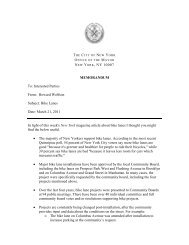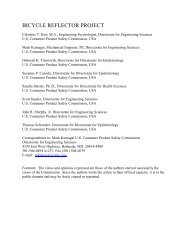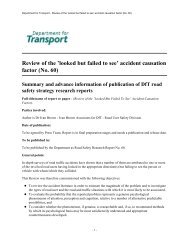Guide for the Development of Bicycle Facilities - The Industrialized ...
Guide for the Development of Bicycle Facilities - The Industrialized ...
Guide for the Development of Bicycle Facilities - The Industrialized ...
Create successful ePaper yourself
Turn your PDF publications into a flip-book with our unique Google optimized e-Paper software.
guide <strong>for</strong> development <strong>of</strong> bicycle facilities 37<br />
On unpaved paths, where bicyclists tend to ride more slowly, a lower<br />
design speed <strong>of</strong> 25 km/h (15 mph) can be used. Similarly, where <strong>the</strong><br />
grades or <strong>the</strong> prevailing winds dictate, a higher design speed <strong>of</strong> 40 km/h<br />
(25 mph) can be used. Since bicycles have a higher tendency to skid on<br />
unpaved surfaces, horizontal curvature design should take into account<br />
lower coefficients <strong>of</strong> friction.<br />
Horizontal Alignment<br />
Unlike an automobile, a bicycle must be leaned while cornering to prevent<br />
it from falling outward due to <strong>the</strong> generation <strong>of</strong> centrifugal <strong>for</strong>ce.<br />
<strong>The</strong> balance <strong>of</strong> centrifugal <strong>for</strong>ce due to cornering, and <strong>the</strong> bicycle’s<br />
downward <strong>for</strong>ce due to its weight, act through <strong>the</strong> bicycle/operator combined<br />
center <strong>of</strong> mass and must intersect a line that connects <strong>the</strong> front and<br />
rear tire contact points.<br />
If bicyclists pedal through sharp turns and lean too far, <strong>the</strong> pedal will<br />
strike <strong>the</strong> ground because <strong>of</strong> a sharp lean angle. Although pedal heights<br />
are different <strong>for</strong> different makes <strong>of</strong> bikes, <strong>the</strong> pedal generally will strike<br />
<strong>the</strong> ground when <strong>the</strong> lean angle reaches about 25 o . However, casual bicyclists<br />
usually do not like to lean too drastically, and 15-20 o is<br />
considered <strong>the</strong> maximum lean angle. Assuming an operator who sits<br />
straight in <strong>the</strong> seat, a simple equation can determine <strong>the</strong> minimum radius<br />
<strong>of</strong> curvature <strong>for</strong> any given lean angle:<br />
For Metric Units:<br />
R = 0.0079 V 2<br />
tan θ<br />
Where:<br />
R = Minimum radius <strong>of</strong><br />
curvature (m)<br />
V = Design Speed (km/h)<br />
θ = Lean angle from <strong>the</strong><br />
vertical (degrees)<br />
For English Units:<br />
R = 0.067 V 2<br />
tan θ<br />
Where:<br />
R = Minimum radius <strong>of</strong><br />
curvature (ft)<br />
V = Design Speed (mph)<br />
θ = Lean angle from <strong>the</strong><br />
vertical (degrees)<br />
However, when <strong>the</strong> lean angle approaches 20 o , <strong>the</strong> minimum radius <strong>of</strong><br />
curvature negotiable by a bicycle becomes a function <strong>of</strong> <strong>the</strong><br />
superelevation rate <strong>of</strong> <strong>the</strong> pathway surface, <strong>the</strong> coefficient <strong>of</strong> friction between<br />
<strong>the</strong> bicycle tires and <strong>the</strong> surface, and <strong>the</strong> speed <strong>of</strong> <strong>the</strong> bicycle. For<br />
this situation, <strong>the</strong> minimum design radius <strong>of</strong> curvature can be derived<br />
from <strong>the</strong> following <strong>for</strong>mula:<br />
For Metric Units:<br />
For English Units:<br />
2<br />
2<br />
V<br />
V<br />
R =<br />
127 e<br />
R =<br />
⎛<br />
⎜ +<br />
⎝100 f ⎞<br />
⎛<br />
⎟<br />
15⎜<br />
e +<br />
⎠<br />
⎝100 f ⎞<br />
⎟<br />
⎠<br />
Where:<br />
Where:<br />
R = Minimum radius <strong>of</strong><br />
= curvature (m)<br />
R = Minimum radius <strong>of</strong><br />
= curvature (ft)<br />
V = Design Speed (km/h)<br />
V = Design Speed (mph)<br />
e = Rate <strong>of</strong> bikeway<br />
= superelevation (percent)<br />
e = Rate <strong>of</strong> bikeway<br />
= superelevation (percent)<br />
f = Coefficient <strong>of</strong> friction f = Coefficient <strong>of</strong> friction<br />
Design<br />
Shared Use Paths





